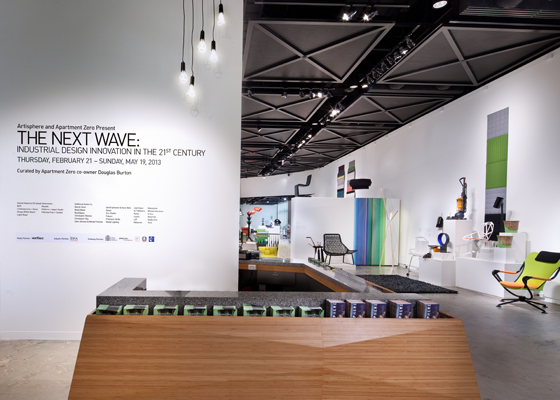Yes We Can: debating the future of American design
Scritto da David Sokol
Washington, DC, Stati Uniti d'America
14.05.13
A recent panel discussion at Washington DC’s International Design Festival got to grips with the somewhat provocative question, “What Happened to American Design?”, the implication being it doesn't enjoy the singular, coherent identity of other national design cultures. Here, journalist and panel moderator David Sokol outlines and extends the debate.
"The Next Wave: Industrial Design Innovation in the 21st Century" is on view at the Washington, DC-area cultural center Artisphere

"The Next Wave: Industrial Design Innovation in the 21st Century" is on view at the Washington, DC-area cultural center Artisphere
×With the launch of the 25th edition of ICFF, the biggest week in contemporary American design is upon us. Thousands are descending upon New York for this Stateside Salone. Almost as many new product roundups and profiles of emerging designers will come of it.
Last month, “Oh Say Can’t You See: What Happened to American Design?” offered a retrospective brace to the coming deluge of trend reports and other forecasts. I was invited to moderate this conversation, which was organized in conjunction with "The Next Wave: Industrial Design Innovation in the 21st Century", the centerpiece exhibition of the new Washington, DC International Design Festival.
Critique was built into the title of the panel discussion—namely, that American design lacks the cohesive identity it once enjoyed. Indeed, one needn’t comb too finely through "The Next Wave" for the implication to come to light. Whereas the Spanish design on display possesses an overarching jubilance, or multiple works by Hella Jongerius embody the Dutch obsession with process, America had no standout ethic, aesthetic, nor poster child. The show’s American selections, curated by Apartment Zero cofounder Douglas Burton, span from the wry wall-mounted bookshelf Juxtaposed: Power by San Francisco–based Mike&Maaike to BioLite’s earnest HomeStove prototype, a smokeless biomass stove intended for underdeveloped countries and partly funded by the federal National Institutes of Health.
Among the other Americans appearing in "The Next Wave" are textiles manufacturer Maharam and New York-based RUX Design, whose "Stickbulb" floor light is shown here on the right

Among the other Americans appearing in "The Next Wave" are textiles manufacturer Maharam and New York-based RUX Design, whose "Stickbulb" floor light is shown here on the right
×Panelists included design journalist Annie Groer, design director for the National Endowment for the Arts Jason Schupbach, and designers Scott Mason, Josh Owen, and Tom Shiner. They eschewed sulking. Groer opened the responses, by remarking that the exhibition’s portrayal of a less unified American front simply reflected life in the Internet age. “There’s fragmentation in design just like there’s fragmentation in every other institution,” Groer said.
Without skipping a beat, Schupbach deemed the “What Happened to” theme “a lost lament for one type of American society.” Later, Schupbach would conclude that new adaptations of social media, such as Kickstarter, only accelerate that multinucleated quality. (Two products in "The Next Wave" raised capital via Kickstarter. More important, both the Urbio vertical garden and Clip Tree organization system were conceived by Americans.)
Selections by curator Douglas Burton from Apartment Zero span the globe, including Hella Jongerius's "Polder" Sofa for Vitra and "Stack" drawers by Shay Alkalay for Established & Sons

Selections by curator Douglas Burton from Apartment Zero span the globe, including Hella Jongerius's "Polder" Sofa for Vitra and "Stack" drawers by Shay Alkalay for Established & Sons
×Yet even within a diverse marketplace, participants noted several directions in which American design is moving. Though Mason said, “contemporary American design is really a [multinational] hybrid of skills and manufacturing processes,” he also observed a rise in American manufacturing of American designs. He credited environmental rating systems like LEED, which privilege local and regional materials, for the change.
Schupbach lauded Minneapolis companies Room & Board and Blu Dot for their American-made missions, adding, “Nowadays, every member of the millennial generation just wants to make things.” Owen, who also teaches at Rochester Institute of Technology, concurred, describing a recent walkthrough of Salone del Mobile with two students: “When I took them around the show, they processed it in a way I hadn’t seen before. In the past, where other students have been starstruck by the European designers, these two surveyed things and immediately wanted to figure out how to bring some of the ideas they saw back to Brooklyn.”
"Juxtaposed: Power", a wall-mounted bookshelf by San Francisco's Mike&Maaike, includes slots fitted specifically to seminal political books like "On Liberty"

"Juxtaposed: Power", a wall-mounted bookshelf by San Francisco's Mike&Maaike, includes slots fitted specifically to seminal political books like "On Liberty"
×Other shifts are just beginning to reveal themselves. Panelists predicted that designers would soon be making things both for Brooklyn and in Brooklyn—following place-based examples that include Design Museum Boston’s ongoing Street Seats: Reimagining the Public Bench competition and Owen’s own temporary Corian installation for DesignPhiladelphia, a predecessor to the Washington, DC International Design Festival. Schupbach reported that the socially responsible design initiatives seeking NEA funding often have this endemic quality, too. Looking even farther ahead, Shiner linked the current repopulating of American cities with potential new movements elsewhere in design. In that vein, Shiner also envisioned new forms deriving from architectural-scale transformations, such as the evolution of public libraries from book repositories to multifunctional spaces.
Arguably, American history is one long golden age of design. From the cabinetmaking that took place in 18th-century Newport, Rhode Island, to the modern definition of design undertaken by Eames Office, consecutive periods of transformative ingenuity and magnetic personality turned the United States into an economic powerhouse. Although of-the-moment events like ICFF or "The Next Wave" lack the singular imprints of past eras, that fact is certainly not for want of skill and ambition.
....



